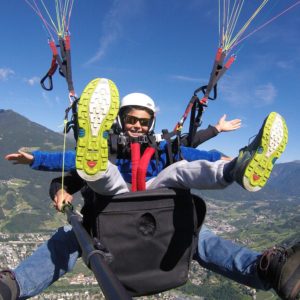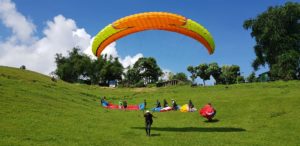Hello, I saw your link on the Facebook group of the French in Mexico. Could you give me some info on the classes to learn to fly alone in Paragliding?
I have already had several baptisms and I would like to learn.
Thank you,Léa 😉
Hello Lea,
Thank you for your interest. Your question allows me to add a page on the site to explain how it works.
1. Discover the activity with a tandem flight

Flight tandem paragliding is often a good way to experience the activity. But it is by no means obligatory.
And in your case, it's already done. But it's true that it's a good way to see if you want to take the plunge and learn to paraglide, and many students come to learn paragliding after such an experience. Note that it is not only at the start of the activity (before its first flights) that it is useful.
As you continue to progress, it may be interesting to fly in educational tandem, with his monitor or another tandem for that matter. This allows to be corrected in real time, and allows to better understand a new site, to learn to walk or to climb in the thermal.
2. Do an beginner's paragliding course

Basically, we gradually discover the activity in safety. The first day we present the equipment, the technical terms (lines, lower surface, upper surface, leading edge, trailing edge, harness ...), then we do our first piloted races: You have to learn to lift the paraglider (inflate it) , stop it above the head, without it falling behind, or on the contrary overtaking us, then run with it in the slope-school, by correcting any roll movements, by refocusing under the sail to reach the lift (the sail "carries" you). These tests should be repeated for another day or two. At first, it's a bit like learning to ride a bike, it's not always easy, even confusing, but learning to paraglide comes pretty quickly.
We also tackle theoretical lessons, because we are not birds, and there are important principles to understand (flight mechanics, flight plan…) To fly safely. In general, it's more like skipping school, rather than lectures.
Then it's time for " great flight". It's always a great time. And you will remember it in 20 years!
We put a radio on your shoulder, an instructor watches you on takeoff, guides you, and hands over to the landing one, which makes you land, always with the radio. We can possibly go through an educational tandem, for those who need to be reassured.
We repeat the flights in calm conditions (a glide from top to bottom), and we gradually gain in autonomy. We do exercises (pitching, ears…) to refine our piloting and then tackle more generous conditions. Gradually we manage to stay in the air (dynamic flight, like the seagull), then later to climb in the thermals, like the birds of prey. Finally, but it really comes later, we can cover kilometers, if the conditions allow it: It is the flight of distance or cross country.
Of course, then you have to be able to tackle stronger conditions, be aware of your level, and not cut corners. Paragliding is not a dangerous activity in itself but “at risk”. An accident - or more often a theft incident - is always due to human error.
Here is a video of a initiation course in France, where I work (the great outdoors):
At the end of such an internship (5 days), you can do between 4 and 8 flights alone, but you are rarely independent at the end of the internship. You have to at least do one more (advanced course) to pretend to fly alone, and again, in calm conditions! And that's a minimum. We all have different skills. We adapt to the conditions of the place and of the day as well ...
You can also try to learn to fly alone or with friends, but your life expectancy may be reduced.
I advise you to take the time to watch this video of Jules, who testifies to his experience on this subject, and which made the buzz when it was released:
3. Progress in safety
As indicated above, at the end of a first paragliding course, you are rarely autonomous.
It is important to be accompanied in its progress. It is better to invest in training before thinking about equip yourself with a paraglider. Or at least being able to count on a trusted pilot, ready to take care of you when you come out of the nest. Paragliding is a slow maturing activity, it takes time to evolve in an environment that is not so familiar to us, the sky. It is easy to skip ahead, ignoring the danger. It is then sometimes difficult to get back in the saddle, or rather harness (the paraglider's harness).
Next to a tandems, my passenger often asks me, like you:
How long does it take to learn to fly on your own?
As you can see the answer is not obvious. I would say from a few days… to a lifetime! This activity teaches humility. English speaking pilots say: There are old pilots and bold pilots, but no old, bold pilots. (There are old pilots and reckless pilots, but there are no reckless old pilots). All is said.
In Mexico, we generally do 10-day internships, to have a little more autonomy, especially since Mexicans have fewer vacation periods than us. It will take me contact to find out the calendar of courses, if you are interested. Everything is possible, even private lessons, but it is more economical to do a course with several people. You can also motivate your friends so that I can organise a course just for you, on a date of your choice 😉
There, I hope I answered your question.
Related : paragliding schools directory and paragliding for dummies.
—
Olivier
